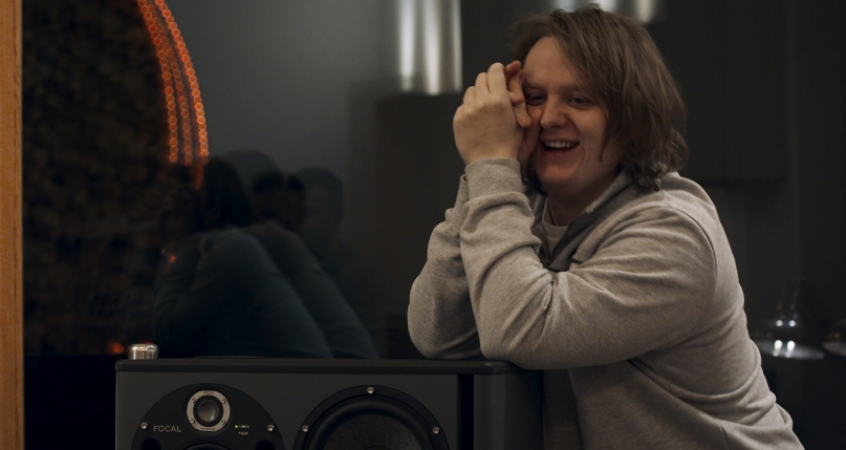
Lewis Capaldi: "Tourette's Syndrome and Anxiety Were Taking Over My Life"
-
Netflix's How I'm Feeling Now is an intimate portrait of Lewis Capaldi's struggles with anxiety and Tourette's Syndrome
-
Therapist Claire de la Varre, whose daughter has TS, explores the common misconceptions about this condition
Tourette’s Syndrome is in the spotlight currently. Recent Netflix documentary How I'm Feeling Now is a behind-the-scenes look at Scottish musician Lewis Capaldi’s life. Capaldi was diagnosed with TS in September 2022.
The film has been praised for showing an unfiltered version of the singer’s reality, both the highs and the lows. Anxiety is also a very real struggle for Capaldi, who describes having panic attacks as: “It feels I’m going insane, completely disconnected from reality. I can’t breathe. I get dizzy. I feel like there’s something happening to my head. I’m sweating. My whole body starts to do what my shoulder does. Like pure convulsing. The big thing for me with it is, I’m always going to feel like this now, this is me. F***. This is it. Either I feel like I’m going to be stuck like that for ever, or I’m going to die.”
Capaldi has since said in The Independent that he only realised how much his anxiety and Tourette's was "taking over his life" since watching the documentary footage back. When Capaldi was first diagnosed with TS, he said he was motivated to make it public “because I didn’t want people to think I was taking cocaine or something”. TS is a widely misunderstood condition, so I wanted to share some of what I know.
Where does Tourette’s Syndrome come from?
TS is an inherited disorder. Parents with Tourette's have about a 50% chance of passing TS to a child, and boys are affected more than girls, although by adulthood that gender difference has disappeared. However, TS itself is often triggered by something in the environment. Recent research is exploring possible links between the onset of TS and prior infection by streptococcus or other pathogens, as well as exposure to prenatal hormones.
As Tourette's Syndrome occurs on a spectrum, and tends to be diagnosed only when causing problems for the child, it is likely to have a higher prevalence in the general population than the usual estimate of 1-2%.
What are the symptoms of Tourette’s Syndrome?
TS often first manifests at age five or six and tends to peak in early adolescence. Tics will wax and wane over time, and new tics may take their place. By later adolescence tics will lessen considerably or even disappear in a majority of children, although in a small percentage they persist into adulthood.
As well as motor and vocal tics, TS often includes cognitive tics, such as obsessive or repetitive thinking, and intrusive thoughts, which may persist even after the motor and vocal tics have faded away.
Tics often become more and more complex as the child ages and may include whole sequences of behaviours or vocal tics that manifest as complex sentences. For instance, a child may be compelled to touch the ground after each step they take or might start hitting themselves in the face. Tics can hurt! Muscles get overused and painful and children become exhausted. TS can also be debilitating socially as children with tics receive greater scrutiny from classmates, are seen as 'weird', or might cause offence with vocal tics.
A minority of people with TS (estimated to be 15-20%) will present with compulsive swearing (coprolalia) – which is the most well-known TS symptom and can cause misunderstandings. This symptom is often made fun of and people with TS are sometimes the butt of comedic skits, sketches, memes and jokes about coprolalia.
Rage attacks (uncontrollable anger) are more common in children with TS and these too are often presented as funny on social media. Fortunately, public awareness about the true nature of TS is increasing due to celebrities like Lewis Capaldi and Billie Eilish recently discussing their own struggles with TS.
For more information see the websites of: Tourette's Action UK, and Tourette Association of America. Films include: Lewis Capaldi's Netflix documentary How I'm Feeling Now (2023), I Have Tourette's, But Tourette's Doesn't Have Me (2005), Brad Cohen's Front of the Class (book, 2005, and movie, 2008). The fascinating book by the late neurologist Oliver Sacks, An Anthropologist on Mars (1995), contains a chapter on TS.
Dr Claire de la Varre is a verified Welldoing therapist in Stirling and online
Further reading
Everything you need to know about intrusive thoughts
How Asperger's Syndrome has shaped my life
What we want others to understand about ADHD
References
Eapen, V. & Robertson, M.M. (2015) Are there distinct subtypes in Tourette syndrome? Pure-Tourette syndrome versus Tourette syndrome-plus, and simple versus complex tics, Neuropsychiatric Disease and Treatment, 11:1431-1436.
Ho, C.S., Shen, E.Y., Shyur, S.D., Chiu, N.C. (1999). Association of allergy with Tourette's syndrome. J Formos Med Assoc. 98(7):492-5.
Hsu, C.J., Wong, L.C., Lee, W.T. (2021) Immunological Dysfunction in Tourette Syndrome and Related Disorders. Int J Mol Sci. 22(2):853.
Janik, P., Dunalska, A., Szejko, N, Jakubczyk, A. (2021). Cognitive Tic-Like Phenomena in Gilles de la Tourette Syndrome. J Clin Med. 10(13):2749.
Kessler, A.R. (2002), Tourette syndrome associated with body temperature dysregulation: possible involvement of an idiopathic hypothalamic disorder. J Child Neurol., 17(10):738-44.
Kumar, A., Duda, L., Mainali, G. et al. (2018). A comprehensive review of Tourette Syndrome and complementary alternative medicine. Curr Dev Disord Rep 5, 95–100.
Lichter, D.G., Finnegan, S.G. (2015). Influence of gender on Tourette syndrome beyond adolescence. Eur Psychiatry, 30(2):334-40.
Mell, L.K., Davis, R.L., Owens, D. (2005). Association between streptococcal infection and obsessive-compulsive disorder, Tourette’s syndrome, and tic disorder. Pediatrics. 116:56–60.
Tsai, C.S., Yang, Y.H., Huang, K.Y., Lee, Y., McIntyre, R.S., Chen, V.C. (2016). Association of tic disorders and enterovirus infection: A nationwide population-based study. Medicine. 95:e3347.










